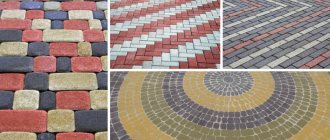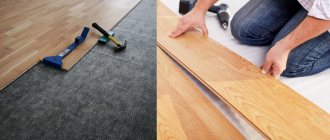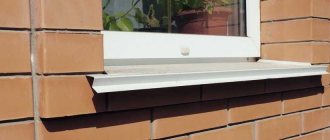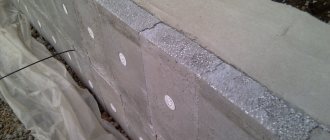As an advertisement
If for professional builders the importance of geotextiles is like an axiom: obvious, proven and undeniable, then private developers are not well enough aware of all the possibilities of this unique material. This picture does not always develop, but quite often. The use of geotextiles in private construction is not so uncommon (rather, on the contrary). But, unfortunately, this material is used quite rarely correctly and for its intended purpose.
It is very easy to make a mistake in choosing geotextiles. Therefore, very often, not only those who completely abandoned this material, but even those who were able to find use for it on their own personal plot have to regret missed opportunities. Paradox? Yes. But the explanation for such an intricate curiosity is very simple: geotextiles are not a finishing solution, which, if it does not correspond to the chosen style, can always be changed (if desired). This is the material that forms the basis, and if the geotextile was chosen incorrectly, then even the most expensive and high-quality material will bring nothing to the owner except costs and disappointments.
Avoiding superficial judgments, we will try to delve into the very essence of the problem. Let's find out, for example, why for the construction of an access road it is necessary to use Dornit geotextiles with a density of 350 g/m2, and not some other? Why is it undesirable to use this same material in the construction of drainage sewers? There are many questions, and so that the most important information is presented logically and consistently, let’s get acquainted with the types and features of the use of geotextiles.
General concept of geotextiles
By definition, geotextile is a special type of synthetic fabric that is manufactured using various technologies and has different physical characteristics. Manufacturing technology and material density are the key factors that determine the final purpose of the geosynthetic fabric. Geotextiles are used:
- in road construction:
- in private and industrial construction;
- in agriculture and even in medicine.
Nowadays, geotextiles are increasingly used in landscape design and private construction:
- Being part of drainage systems, geotextiles protect the perforation of underground pipes from clogging, and bulk materials from mixing with the soil and from spreading (thereby it extends the service life and increases the efficiency of drainage communications).
- The use of geotextiles during the construction of the foundation is an opportunity to provide additional reinforcement of the base. Strengthening the underlying layer (for example, sand bedding), protecting it from mixing with natural soil - all this helps to reduce the consumption of building materials and reduce construction shrinkage.
- During the construction of a roadway, geotextiles protect crushed stone from mixing with the soil, thereby allowing the thickness of the asphalt pavement to be reduced without losing its quality (the same functions are performed by geotextiles during the construction of pedestrian paths).
- It is completely impossible to imagine the improvement and decoration of a personal garden without geotextiles. It provides mechanical protection for film waterproofing used in the construction of reservoirs. Geotextiles also help protect decorative hills or landscape terraces from crumbling. Geosynthetic fabric increases the load-bearing capacity of the soil by an order of magnitude, and this quality is in demand wherever there is a need to strengthen bulk layers or protect materials susceptible to mechanical damage.
Brief description and scope of use
At the heart of drainage systems, geotextiles play the role of a reliable filter that prevents the drainage material or drainage pipe from flooding. This is a special type of building material. Mineral, basalt, synthetic and glass fiber are used for its manufacture. The product can be made in the form of a canvas, tape or a three-dimensional structure.
The product is used in a variety of industries (construction, light industry, medicine) and to achieve various purposes:
- protection;
- reinforcement;
- waterproofing;
- soil thermal insulation;
- filtration;
- drainage;
- road surface design;
- delineation of layers of materials of different fractions (formation of dense and durable layers).
Raw materials for the production of geosynthetic fabric
Most often on sale you can find geotextiles made from polyester and polypropylene fibers. Thanks to its high strength and durability, polymer geotextiles have gained popularity in the construction industry and agriculture - where these qualities are valued most.
Less common are geotextiles made of fiberglass and various natural inclusions (textile industry waste: cotton, wool, etc.). The use of natural fillers somewhat limits the scope of application of the material. Such fabric, for example, is not recommended for use in the construction of drainage communications, since it quickly wears out, and this leads to clogging of drainage systems.
general description
Geotextile or geofabric is an elastic synthetic fabric with a thickness of 0.5-5.0 mm, capable of transmitting moisture and air in only one direction. For production, nylon, polyamide, polyester, polyester, acrylic, aramid are used, as well as fiberglass if it is necessary to stitch the fabric.
This material is highly durable and is not susceptible to negative mechanical and chemical influences. It will not be spoiled by insects and rodents, plants cannot grow through it, and it is not susceptible to rotting or low temperatures.
At the same time, by passing incoming moisture to the lower drainage layer of the base of the garden path, geotextiles prevent swelling of the soil when it freezes in the cold season. That is why this rolled material has become widespread in recent years as a universal and multifunctional insulator.
Construction of paths with and without geotextiles. Drawdown of the base.
Polypropylene geotextile
Geo-fabric made of continuous polypropylene fibers is a material based on a thermoplastic polymer with increased chemical resistance. Polypropylene fibers are a product of the polymer industry, which is a primary, that is, unprocessed raw material. The use of solid fiber gives the fabric high strength, but when exposed to sunlight, polypropylene threads quickly lose their strength. This problem is fixable: by adding chemical stabilizers to the product that protect it from exposure to ultraviolet radiation, polypropylene geotextiles are successfully used in a wide variety of areas of human activity. The relatively high cost of polypropylene geotextile is a consequence of the technological features of production.
Geotextile properties
All types of geotextiles we offer are distinguished by the following properties:
1.good water permeability, which allows the coating to be used to equip drainage and filtration systems;
2.absence of harmful inclusions and additives;
3.high level of strength, resistance to serious loads;
4.tolerance of prolonged exposure to ultraviolet radiation, moisture, temperature fluctuations;
5.elasticity and ergonomics, which greatly simplifies the installation process;
6.flat surface, which makes it possible to distribute the load evenly over the entire surface.
Polyester Geotextile
Polyester geotextile is a material made from short polyester fibers. They are based on recycled materials (plastic waste, polymer production waste, etc.), which significantly reduces the cost of the canvas, but gives it sufficient strength.
A suitable example of quality, durability and practicality is Dornit brand polyester geotextiles with a density of 250 g/m² - a popular and economical solution for low-rise construction, landscape design and complex landscaping of homestead areas.
With this, the classification of geotextiles based on materials of manufacture can be completed. There are not so many options, and their differences are clear even to the uninitiated.
The situation with production technology is much more interesting, because the area of application of geotextiles depends on it.
Based on the manufacturing method, geotextiles are divided into two main types: woven and non-woven.
Types of geotextiles
Geotextiles are divided into varieties according to several criteria - material and manufacturing method, and areas of application. Therefore, we will consider each of them further.
Geotextile material
Geotextile fabrics consist of the finest synthetic fibers made from different materials, which can be combined in different proportions. Depending on the dominance of one or another component in the composition of geotextiles, it is divided into the following types:
- Polypropylene geotextiles have increased resistance to various external influences and excellent filtering qualities, as well as good strength.
- Polyester geotextiles primarily consist of the finest polyester (polyester) fibers. The material is resistant to chemical influences, environmentally friendly, quite durable and elastic.
- Multicomponent (mixed) geotextiles. This type of material includes various components made from recycled materials - this can be waste from wool, cotton and viscose production. Mixed types of canvases have a more affordable price, unlike the first two options, however, they are inferior to them in strength and durability, and are not as reliable. This is due to the fact that the substances that make up this type of geotextile are natural, and therefore gradually decompose and are destroyed under the influence of external natural factors.
Method of making canvases
These unique fabrics, at first glance, resemble ordinary classic fabric, however, as mentioned above, it can be made in different ways. Thus, on sale you can find non-woven (thermal bonded and needle-punched) geotextiles, as well as woven and knitted materials.
The diagram shows the classification of geotextiles into main types and their characteristic features
- Woven geotextiles or geofabric are produced in the same way as ordinary fabric, that is, by simple or complex, but always “organized” weaving of threads according to some pattern.
Even from the “pattern” of the threads it is noticeable that this geotextile belongs to the woven variety.
Polyester and glass fibers are used to make this material. Additionally, the finished fabrics are impregnated with reinforcing compounds and passed through special calenders, where partial melting of the threads occurs, due to which the surface of the material becomes denser. Woven fabrics are used to separate layers when creating paths, strengthening structures and distributing the load on the base.
- Non-woven needle-punched geotextiles are made from polyester or polypropylene fibers that are needle-punched.
At first glance, such needle-punched non-woven geotextiles are very reminiscent of ordinary felt fabric.
This method of manufacturing the material includes several stages, the first of which is the formation of a loose layer of fibers of various lengths. Initially, such a layer looks like ordinary cotton wool, the mass of which must be evenly distributed on the surface, otherwise the fabric will have different thicknesses. Next, the raw materials laid out in this way begin to be felted, that is, compacted using needles with special notches. The needles, passing through the layer of fibers, intertwine them, fastening them together. This production technology makes it possible to obtain a geofabric that is highly permeable to moisture.
In Russia, the most famous domestic manufacturer of this material is Dornit, which supplies the domestic market with material with the same name. This type of geotextile is resistant to mechanical stress and high loads, it has good strength and does not deform during operation.
Needle-punched geotextiles can be reinforced with geogrid, which increases its strength and durability.
Prices for geotextiles
geotextiles
Roll of construction geotextile
Needle-punched materials also include geotextiles, which are called construction textiles.
- Non-woven thermofixed geomaterial is also made from polypropylene or polyester, but only using heat treatment technology. The material has a homogeneous structural structure, has good filtering ability and tensile strength. The fabrics are resistant to chemical influences and moisture, so geotextiles do not rot and mold does not grow on them.
Due to the sintering of fibers during heat treatment, thermofixed geotextile acquires increased strength qualities without losing elasticity.
Thermally bonded geotextile is made from molten granules of raw materials using the extrusion method, and then microscopic fibers are applied to its surface. Then the canvases are exposed to high temperatures, from which the threads melt and sinter together. Thanks to this process, geotextiles of this type acquire increased mechanical strength, which distinguishes them from other non-woven materials. The material is used to separate bulk layers, has excellent elasticity, and therefore is able to withstand high loads. This type of geotextile is produced in Russia by a well-known company - its products are intended for use in various fields of construction.
- Knitted geofabric with stitching. This version of the fabric is made from the same materials as the products described above, but in this case the main fibers are stitched with a strong thread.
Clearly different from its “brothers”, knitted geotextiles with stitching.
Fabrics of such geotextiles are excellent for moisture permeability, but are not very resistant to mechanical stress. However, they also have worthy uses.
You can additionally note that geofabric made from polyester fibers is less resistant to chemical influences than the polypropylene version of the fabrics. Therefore, when choosing a material, it is necessary to take into account the scope of its application.
On sale you can find geotextiles made in two versions - with and without strengthening impregnation. Substances such as polymer resins with plasticizers, latex and special components necessary for some areas where geotextile is used are used as impregnations. The impregnated material essentially becomes a flexible composite roll of plastic reinforced with synthetic fiber.
Woven geotextile
Woven geotextiles (geofabric) are made using classical technology, which is based on the mutual interweaving of longitudinal and transverse fibers. This material has high tensile strength and can withstand breaking loads well. These qualities determine the area of application of geofabric:
- construction of reinforced earth embankments;
- arrangement of retaining fortifications;
- arrangement of foundations with complex configurations;
- road construction;
- complex construction work, construction of engineering infrastructure and so on.
Laying and fastening technology
With the classical technology of constructing paths and platforms from paving slabs, geotextiles are laid twice. The first time - to the bottom of a compacted trench dug for the foundation:
- Initially, the soil is removed to the required depth and leveled;
- sand is added to the bottom of the trench with a layer thickness of 2-3 cm;
- the surface is thoroughly compacted;
- Along the trench, the required number of geofabric sheets are laid at the bottom, arranged in parallel, overlapping each other and turning over the walls;
- the width of the overlap of parallel sheets is 15-25 cm, the turn on the walls, depending on the depth of the trench, is 25-30 cm;
- The panels are fixed using metal staples or soldering (for polyethylene and polyester polymers) using an industrial hair dryer or soldering torch.
Non-woven geotextile
Non-woven geotextiles, in turn, can be thermally bonded and needle-punched. In the first case, geotextile fibers are bonded together under the influence of high temperature, in the second - under the influence of a mechanical press with needles.
Thermally bonded geotextiles are made exclusively from polypropylene fibers. This determines its main qualities: strength and elasticity.
Thermally bonded geotextiles are successfully used to strengthen the soil during construction on slopes. Also, its qualities can hardly be overestimated if you are planting trees or improving plant areas (it retains moisture well, thereby allowing you to increase the intervals between watering plants by an order of magnitude). But due to the low filtration coefficient, this material should not be used in the construction of drainage communications, because it allows water to pass only in the transverse direction.
No. 2. Types of geotextiles: geofabric and geotextile
Geotextiles are divided into two groups:
- geotextile;
- geotextile.
Geofabric is made using the knitting and stitching method. Threads of different strengths (1-3 mm thick) are intertwined at right angles, which makes it possible to achieve strength and elasticity, but the final strength directly depends on the density of the fibers and the distance between them. The geotextile is elastic, tensile strength (withstands up to 1000 kN/m2) and has a low water permeability. It is used for reinforcing and increasing the bearing capacity of soil during the construction of roads, airfields, solid waste landfills, as well as for the organization of steep slopes, in civil engineering and landscape design.
Geo -fabric is a non-woven material that is produced by needle-punched or thermally bonded methods from polyester, viscose, polyamide, polypropylene or other polymer fibers. This material is characterized by low strength, but decent elasticity and water permeability, so geotextile is widely used for drainage, filtration and as a separator between different layers.
Needle-punched geotextiles are an indispensable solution for private construction
To produce needle-punched geofabric, both short and continuous polymer fibers are used. The mechanical method of fastening fibers simultaneously gives the fabric both strength and a high filtration coefficient. This significantly expands the scope of its application. Considering that modern technologies make it possible to produce material with specified density parameters, it is difficult to find a more suitable synthetic fabric for private construction than needle-punched polyester geotextiles.
What is geotextile?
Geotextile is a synthetic material of woven or non-woven types. The latter has fibers, but does not have a structured weave. In woven fabric, the threads are woven, as in ordinary fabric. The fibers are drawn from polyester or polypropylene. Sometimes cotton and wool are mixed into them. It all depends on the purpose and type of dornite.
Geotextile Dornit non-woven road type
Geotextiles are produced in sheets or rolls. Their width and winding length may vary. Also, dornite is not only white, but also black and gray. There is no need for color.
Density of geotextiles and areas of its application
For private construction, for work related to landscaping, as well as for the construction of temporary local roads, construction experts recommend using Dornit needle-punched polyester geotextiles, the density of which varies from 150 to 350 g/m².
On the one hand, this material is inexpensive, thanks to which the average private developer can purchase it without any problems, on the other hand, the characteristics of the material fully correspond to the listed areas of application. The Dornit classification by density has a step of 50 g/m², and each subsequent classifier step has its own narrowly targeted purpose.
To understand how to choose the right fabric based on density, let’s look at several examples of the intended use of needle-punched geotextiles.
Criterias of choice
Types of geotextiles differ in composition and technical characteristics. The choice of material is directly related to the specific design conditions in each specific case.
In this matter, an individual developer should pay attention to such characteristics of geotextiles as flatness, fabric thickness, elasticity, etc.
By density
The density criterion is the most significant indicator on which the effectiveness of the material depends on the given conditions:
geotextiles with a density of 150 to 200 g/m2 are suitable for draining groundwater and installing drainage layers;- fabric with a density of over 250 and up to 300 g/m2 is strong enough to reliably separate the soil base from the sand and crushed stone foundation cushion;
- high-density geotextiles (from 350 g/m2) are capable of ensuring uniform distribution of loads on the soil through the foundation slab under brick and other heavy houses.
By thickness and other parameters
The degree of compressibility, as well as the wear resistance of such a substrate under the pressure exerted by the structure on the ground, depends on the thickness of the geotextile. The optimal value for slab foundations is from 1.8 to 3.8 mm.
When choosing a material, they also pay attention to moisture resistance, susceptibility to mold, elasticity and other characteristics specified in the specification for the product.
The better the performance, the more expensive the cost of the material , so you first need to study the design conditions, and then determine the technical tasks that geotextiles must cope with.
The video will tell you how to choose geotextiles:
Geotextile with a density of 150 g/m²
Geotextile "Dornit" 150 g/m² was developed specifically for the construction of drainage systems and for strengthening the soil when organizing drainage communications. The small pores of denser geotextiles quickly become clogged with solid microparticles of soil, thereby reducing the filtering capacity of the material. At the same time, the material, with a density of 150 g/m², is ideal for drainage and excellently strengthens weak foundations.
Geotextiles for drainage (geofabric): technical characteristics and scope of application
Geotextile for drainage or other systems is a material that has high performance:
- rigidity;
- elasticity;
- porosity.
It is these qualities that make it possible to use it for strengthening the soil, dividing the territory, filtering wastewater, protecting the slopes of the site, arranging drainage, etc.
Geofabric has gained particular popularity in Europe, where the construction of highways is indispensable without its use. The synthetic origin of the material allows it to retain its characteristics for a long time, and its high strength allows it to withstand severe loads. Some manufacturers produce geotextiles with a tensile density of up to 250 kg.
A characteristic feature of geotextiles is rigidity, elasticity and porosity.
When it comes to private or industrial construction, geofabric also has its place here. It is widely used for the arrangement of urban sewer systems, in the construction of houses, railways, highways, in gardening and for drainage. What density of geotextiles is required for use in a particular area? For example, for the construction of drainage systems, geofabric with a density of 200 g/m³ and higher is used, for landscaping work about 100 g/m³ is enough, and in the construction of runways for aircraft – 800 g/m³.
The principle of operation of this material is very simple: it is a layer that is used to separate two other layers from each other, while providing additional density. For example, it helps to significantly reduce the risk of sinkholes on the road, and also prevents erosion of the area by groundwater.
Geotextile with a density of 200 g/m²
Geotextile "Dornit" 200 g/m² is designed to strengthen unstable and weak soils. It is used in the following situations:
- when it is necessary to arrange a lawn on a personal plot: to stabilize the soil or protect the soil from deformation;
- when it is necessary to strengthen an unused embankment;
- during the construction of pedestrian paths and decorative slopes.
Most often, people who engage in landscape design use material with a density of 200 g/m². With its help, you can effectively separate layers of soil in unexploited areas or protect lawns from the germination of weeds.
Purpose of geosynthetic material during foundation construction
Waterproofing of building structures is one of the important elements of protecting buildings and structures from environmental influences. Waterproofing of all types of foundations deserves special attention in this matter, because contact of moisture with reinforced concrete or metal certainly leads to a decrease in the performance characteristics of foundations.
Geotextile is a thermally treated fabric made of polyester fibers that has all the necessary functions to protect the base from water and chemical reactions.
Advantageous characteristics of the material:
is durable (up to 50 years);- does not absorb soil moisture;
- resistant to temperature changes in the range from –60 to +100 °C;
- not susceptible to the formation of fungus and mold;
- prevents plant roots from germinating;
- protects the foundation from rodents;
- environmentally friendly raw materials.
Geotextiles are effective in the construction of slab foundations on various soils:
- Sandy ones, which, despite their high load-bearing capacity and low degree of heaving, are permeable to groundwater.
- Clay ones are too mobile to guarantee the durability of the structure, so they need reinforcement.
- Peat - they represent too weak a foundation and in this case the builder needs to recreate a stable support.
Functions of the canvas
The purpose of geotextiles for slab foundations is as follows:
- Reinforcement – makes the base of the structure elastic and at the same time is responsible for the distribution of loads. Reinforcing geotextiles several times increase the bearing capacity of the soil under the base of the foundation. If you plan to build a complex structure on a slab with uneven pressure on the base, then it makes sense to use geotextiles with a density of 350 to 600 g/m2.
- Drainage - removes groundwater from the base of the foundation, preventing moisture from penetrating into the structure of materials above the geotextile. To serve as a drainage barrier, the material must have a density of at least 200 g/m2.
- The separation of the cushion and the soil prevents the process of siltation of sand from developing, as well as the mixing of various materials with each other. As a result, the pillow does not lose its drainage properties and load-bearing capacity during operation.
Geotextile with a density of 250 g/m²
Needle-punched geotextiles with a density of 250 g/m² are chosen by those who plan to undertake large-scale construction work on their own personal plot. This material is optimal for strengthening the soil under the foundation by laying a sheet under a sand cushion. It reliably separates the shock-absorbing bedding from the main soil and allows you to evenly distribute the loads along the entire perimeter of the foundation. At the same time, Dornit 250 g/m² is successfully used to strengthen blind areas, as well as for mechanical protection of polymer film used in the construction of swimming pools and artificial reservoirs.
Rules for laying geotextiles
The methods of laying geotextiles are very similar to each other, so they are all combined into one common technology.
- It is necessary to begin laying by preparing the soil. Before laying geotextiles on the ground, it is necessary to completely level and level it. This means removing all rocks, roots, stumps and other foreign elements from the area. To identify all possible defects, it is recommended to carry out a test rolling of the blade, with the help of which all existing irregularities are identified;
It is very important to ensure that it is smooth without any roughness or bumps. Only under such conditions will the material be perfectly settled, which will greatly extend its service life.
- The geotextile roll is rolled out manually or using attachments. The main requirement is the absence of folds on the material laid on the surface. It is strictly prohibited to move large fragments of laid geotextiles along the surface by dragging or to move working equipment or construction workers along the laid surface;
- Laying the canvas. Initially, it is necessary to roll out the rolls on a specially prepared surface. Geotextiles can be laid in transverse and longitudinal positions. The technology makes it easier to lay longitudinally, but it will not be able to provide even strength across the entire width of the embankment. In order for all the pieces of geofabric fabric to be firmly and evenly connected, they need to be laid with an overlap, the width of which should be about 30 cm. If the surface on which the material is laid is uneven, then the width of the overlap is increased to 50 cm. Transverse materials are laid by lining the following sheets under the previous ones . If the technology is not followed, a shift in materials may occur;
- Connection of geofabric layers. Despite the fact that geotextiles are laid overlapping, sometimes additional connection of the sheets is still required. Indeed, with gusts of strong wind, the canvas can shift and disrupt the overall structure of the material. This can be fastening with metal and plastic staples, fastening with anchors and using welding.
It is very important that the geotextile sheets are tightly connected.
If fastening occurs by welding, then the overlap of the panels can be left at about 10cm. Welding work should only be carried out using a low-temperature gas torch, which has a wide grip diameter. During operation, the burner nozzle must be positioned at a distance of 20 cm from the surface of the canvas. The next rolled roll is pressed against the already heated surface of the previous one. Welding today is considered the most economical method of laying geotextiles. The edges of the roll are attached to the base of the soil with dowels;
- After the geotextile is distributed over the surface, it is covered with crushed stone, sand or any other inert material. After leveling the backfill over the surface, it is compacted;
- The last step is compaction. After distributing the inert material over the canvas, it needs to be compacted. Compaction methods can be static or dynamic. In this matter, you need to know the quality of the underlying soil and the material itself with which the geotextile was filled. Compaction is done using special automotive equipment or a tamping machine.
During the process of compacting the geotextile, it is very important not to damage it, otherwise the structure may collapse in the future.
Special equipment can begin to move around the area where geotextiles are laid only if the thickness of the backfill is at least 200 mm. Otherwise, it is allowed to use only lightweight equipment to avoid damage to the canvas.
Although geotextiles can be laid correctly using other technologies, this is the most common and effective. Of course, laying geotextiles on a summer cottage, making garden paths, is one thing, but laying geotextiles under the surface of a highway or expressway is quite another.
Geotextile with a density of 350 g/m²
Needle-punched geosynthetic fabric, with a density of 350 g/m², has also become widespread in private construction. This material is most suitable for the construction of reliable access roads, car parks or massive foundations. It can also be used to solve other problems that have a similar purpose and corresponding level of complexity.
Color
Geotextiles made from recycled materials are available in brown, light brown, and sand colors.
White and black canvas is most often produced to order.
Since the scope of use of needle-punched material has nothing to do with its appearance, white or black colors are most often used for purposes other than their intended purpose.
The main advantages of Dornit brand needle-punched geotextiles
The key advantages of the presented material lie in the almost unlimited scope of its application, as well as in the unchanged performance characteristics throughout the entire period of operation (which, by the way, reaches 25 years). It is characterized by:
- strength and durability, which are achieved by using non-degradable geosynthetic materials;
- resistance to vibrations and temperature changes;
- good filtering ability even under extreme operating conditions (intense vibrations, strong mechanical pressure, etc.);
- environmental friendliness and affordable cost.
By the way, about the cost: the price of the material includes all the costs that are required by impeccable adherence to production technology, the cost of purchasing high-quality raw materials, as well as the cost of operating high-tech production equipment. If you like geotextiles that are too low in price, it means that one or another cost item is not included in its cost. Consequently, the material was produced in violation of technology or using low-quality raw materials.
It is impossible to create high-quality material without appropriate investments, so cheap geotextiles will have neither reliability nor durability. By purchasing geosynthetic fabric from official dealers who directly cooperate with the manufacturer, you will always receive guaranteed quality at a reasonable and reasonable cost.
Subscribe to our Telegram channel Exclusive posts every week
How do geotextiles strengthen paths?
The use of geotextile is only gaining momentum, which is why the opinion of opponents of this technology is still very strong. However, the practical use of roads for which it was decided to lay geotextiles proves the opposite.
The use of geofabric greatly improves the performance properties of the road surface, since geofabric demonstrates high resistance to tearing, durability and the ability to drain water. A path built using geosynthetics receives an additional margin of safety due to:
- Improved bearing capacity
of the substrate and road surface. - Lack of germination
of weeds and other plants whose roots can disrupt the evenness and integrity of paving slabs. - The separation of layers
is maintained throughout the entire life of the track due to the biostability and corrosion resistance of geotextiles. - The strength of the layers is maintained
, since crushed stone and sand do not mix, and the density of these layers remains constant even with heavy traffic on the road when geotextiles are laid under paving slabs. - There is no destructive effect of water
, since all moisture leaves through the drainage layer, and this saves from erosion during intense rains and freezing of water in the structure of paving slabs. - The soil is strengthened
, which is why geotextiles should be laid. Therefore, paths of any configuration can be built on both weakened and depleted soils. - Simplified repair
, because the damaged area can be dismantled and geotextiles can be laid again under the paving slabs in compliance with the layers of building materials.
This is not a complete list of the advantages that the use of geotextile provides; the main thing is careful adherence to installation instructions and the choice of trusted suppliers of materials.
Geotextiles - why is it so important when installing
In construction, the use of geofabric is quite popular; various industrial facilities are decorated with this material and add originality to landscape design. This is where the question arises, for what purposes are geotextiles used when arranging tiled flooring, and is it needed at all?
After all, such fabric had not been used before, and yet the paving stones remained just as attractive for a long time. You can’t argue with this; indeed, paving slab coatings have always served for a long time, but with geotextiles as a base, the service life of the path increases even more. In addition, it becomes easier to care for such coating.
Base for paving stones made of geotextile
The fact is that using this material provides a large number of advantages. The fabric is resistant to rotting and is of no interest to insects and rodents, it easily tolerates exposure to ultraviolet rays, and these are not all the advantages of the material; we can talk about them for a long time. Therefore, geofabric must be used for paving paving stones.
But if we identify the main tasks that the material performs, this is, first of all, making the tile flooring reliable. The laid backing fabric under the paving slabs separates the base layers and filters moisture that comes in the form of groundwater or precipitation. In addition, the problem of weed germination is also solved. It’s not for nothing that builders claim that if geotextiles are not used when laying paving slabs, then labor and money are wasted.
The use of material allows you to equip a high-quality base










